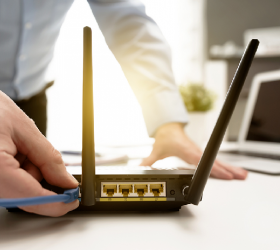A Wi-Fi network at home can effectively control all the technical devices at home by connecting them to a single device. Nowadays, consumers can even access their refrigerators, home assistants, TVs and cooking appliances with Wi-Fi. The first and foremost thing one needs to keep in mind after buying the router is the internet setup. Though this might sound trivial, improper installation and lacklustre after-sales service from the internet providers can make the whole process of internet consumption wearisome. Proper internet setup, excellent after-sales service, and knowing the security tips are vital in the Wi-Fi’s smooth functioning.
Here’s a look at some of the perks of having a home wireless network:
- Since the Wi-Fi networks are wireless, they enable users to connect to the source network from any convenient position within their homes. With the increasing demand for portable smart devices, this is significantly relevant.
- Now, files can be transferred between two computers using a network sharing facility. This option is more viable and flexible than file transferring using disk drives. Apart from sharing photos, audio files and videos, one can also transfer copies of valuable data to another computer. File backup is critical in safeguarding the security of users’ data.
- One of the critical advantages of having a home networking facility is that multiple users can access the internet without paying the service provider. Though multiple connections can slow down the network a bit, broadband services can tackle this hurdle with ease.
- With the advent and expansion of home networking facilities, one can connect multiple computers to a single printer and make printing less troublesome. Similarly, one can also use other electronic devices like speakers and home assistants in the same manner.
- Most of the popular online games across various platforms now support multiplayer options using LAN and the internet. This feature enables friends and family to play together with ease.
- Wi-Fi calling is now gaining popularity among mobile users worldwide. Android and iOS platforms have now recognised this feature’s possibilities and are continually striving to optimise the users’ VoIP calling experience.
- Various home entertainment devices such as speakers, DVRs and gaming consoles are now Wi-Fi enabled. Incorporating these devices into one’s network ensures a seamless and rounded experience.
- Using Wi-Fi, one can easily set up a device without dealing with long, unnecessary cables. From a common access point, users can access the internet without any hassle or delay.
- Everyone knows that wireless networking services are very cost-effective in both implementation and overall maintenance than wired networks. The lack of physical wires and other unwanted cables significantly reduces the maintenance cost.
- In most cases, Wi-Fi networks are way faster than mobile internet providers. The difference is particularly evident while transferring large video files or streaming videos online. Additionally, one must preferably download large files and update one’s system/UI over Wi-Fi for an uninterrupted experience.
- In the case of smartphones, longer battery life is one of the most sought after features. In low battery conditions, one would be unable to use several components like camera, voice recording, gaming features, etc. Accessing the internet using Wi-Fi only consumes less power than using mobile data and thus providing longer battery life.




